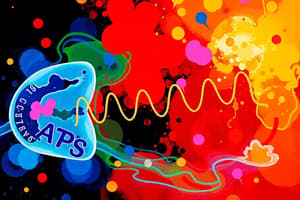Podcast
Questions and Answers
Why is glucose attached to a phosphate group during glycolysis?
Why is glucose attached to a phosphate group during glycolysis?
- To ensure glucose remains within the cell. (correct)
- To convert glucose into a transportable form.
- To signal the start of the Electron Transport Chain.
- To provide energy for the glycolytic pathway.
Where does glycolysis take place in the cell?
Where does glycolysis take place in the cell?
- Mitochondria
- Cytoplasm (correct)
- Nucleus
- Endoplasmic Reticulum
What is the net production of ATP molecules in glycolysis?
What is the net production of ATP molecules in glycolysis?
- 4 ATP
- 30-32 ATP
- 36-38 ATP
- 2 ATP (correct)
What is the primary fate of pyruvate after glycolysis under aerobic conditions?
What is the primary fate of pyruvate after glycolysis under aerobic conditions?
Which of the following is the end product of glycolysis?
Which of the following is the end product of glycolysis?
How many carbon atoms are present in a molecule of pyruvate produced during glycolysis?
How many carbon atoms are present in a molecule of pyruvate produced during glycolysis?
Which process yields the majority of ATP from glucose?
Which process yields the majority of ATP from glucose?
What is the net production of NADH molecules during glycolysis per molecule of glucose?
What is the net production of NADH molecules during glycolysis per molecule of glucose?
How many ATP molecules can one molecule of glucose generate after complete oxidation through glycolysis, the citric acid cycle, and the electron transport chain?
How many ATP molecules can one molecule of glucose generate after complete oxidation through glycolysis, the citric acid cycle, and the electron transport chain?
Which of the following conditions is NOT required for glycolysis to occur?
Which of the following conditions is NOT required for glycolysis to occur?
What is the role of hexokinase in glycolysis?
What is the role of hexokinase in glycolysis?
Which of the following is true about irreversible steps in glycolysis?
Which of the following is true about irreversible steps in glycolysis?
Which of the following enzymes catalyzes the rate-limiting step in glycolysis?
Which of the following enzymes catalyzes the rate-limiting step in glycolysis?
What type of molecule is glyceraldehyde-3-phosphate (G3P)?
What type of molecule is glyceraldehyde-3-phosphate (G3P)?
If glycolysis is allowed to proceed, how many molecules of glyceraldehyde-3-phosphate (G3P) are produced from each molecule of glucose?
If glycolysis is allowed to proceed, how many molecules of glyceraldehyde-3-phosphate (G3P) are produced from each molecule of glucose?
Which enzyme catalyzes the conversion of 3-phosphoglycerate to 2-phosphoglycerate?
Which enzyme catalyzes the conversion of 3-phosphoglycerate to 2-phosphoglycerate?
Which enzyme catalyzes the final step of glycolysis, producing pyruvate?
Which enzyme catalyzes the final step of glycolysis, producing pyruvate?
Which of the following molecules is produced by the enzyme enolase?
Which of the following molecules is produced by the enzyme enolase?
What is the significance of the first step of glycolysis where glucose is converted to glucose-6-phosphate?
What is the significance of the first step of glycolysis where glucose is converted to glucose-6-phosphate?
Where is glucokinase found?
Where is glucokinase found?
Flashcards
What is Glycolysis?
What is Glycolysis?
The breakdown of glucose, occurring in the cytoplasm of all cells.
End product of glycolysis?
End product of glycolysis?
Pyruvate (pyruvic acid). It then enters the mitochondria for further processing.
Net ATP production from glycolysis?
Net ATP production from glycolysis?
2 ATP molecules.
Where does pyruvate go after glycolysis?
Where does pyruvate go after glycolysis?
Signup and view all the flashcards
Overview of Glycolysis
Overview of Glycolysis
Signup and view all the flashcards
Carbon count: Glucose vs. Pyruvate
Carbon count: Glucose vs. Pyruvate
Signup and view all the flashcards
Energy and oxygen: Glycolysis
Energy and oxygen: Glycolysis
Signup and view all the flashcards
Net molecules products of glycolysis?
Net molecules products of glycolysis?
Signup and view all the flashcards
Where does glycolysis end?
Where does glycolysis end?
Signup and view all the flashcards
Role of Glucose-6-phosphate?
Role of Glucose-6-phosphate?
Signup and view all the flashcards
Why is Glucose-6-phosphate important?
Why is Glucose-6-phosphate important?
Signup and view all the flashcards
Enzymes for Glucose-6-phosphate?
Enzymes for Glucose-6-phosphate?
Signup and view all the flashcards
Enzyme for Fructose-6-phosphate?
Enzyme for Fructose-6-phosphate?
Signup and view all the flashcards
Enzyme for Fructose-1,6-bisphosphate?
Enzyme for Fructose-1,6-bisphosphate?
Signup and view all the flashcards
Enzyme for Glyceraldehyde-3-phosphate (G3P)?
Enzyme for Glyceraldehyde-3-phosphate (G3P)?
Signup and view all the flashcards
Enzyme: 1,3 bisphosphoglycerate (1,3-BPG)
Enzyme: 1,3 bisphosphoglycerate (1,3-BPG)
Signup and view all the flashcards
Enzyme: 3-phosphoglycerate
Enzyme: 3-phosphoglycerate
Signup and view all the flashcards
Enzyme: 2-phosphoglycerate
Enzyme: 2-phosphoglycerate
Signup and view all the flashcards
Enzyme: Phosphoenolpyruvate (PEP)
Enzyme: Phosphoenolpyruvate (PEP)
Signup and view all the flashcards
Enzyme for Pyruvate?
Enzyme for Pyruvate?
Signup and view all the flashcards
Study Notes
- Glycolysis involves the breakdown of glucose and is the beginning process of metabolism
- Glycolysis occurs in the cytoplasm of all cells
- Glucose is attached to a phosphate group to keep it inside the cell
- The end product of glycolysis is pyruvate (pyruvic acid)
- Net production of glycolysis is 2 ATP molecules
Overview of Glycolysis
- A series of enzymatic reactions breaks down glucose into 2 pyruvate molecules
- Glucose is a 6 carbon sugar; pyruvate is a 3 carbon molecule
- Energy is produced via ATP
- Glycolysis does not utilize oxygen
- The net production is 2 ATP and 2 NADH molecules
- The end product (pyruvate) enters the Kreb's cycle (citric acid cycle) and the Electron Transport Chain (ETC)
- One molecule of glucose will generate 30 to 32 ATPs through the ETC
Steps of Glycolysis
- Glucose-6-phosphate is an irreversible step, which prevents it from leaving the cell
- Enzymes involved are hexokinase (in all cells) and glucokinase (found in the liver and β-cells of the pancreas)
- Fructose-6-phosphate involves the enzyme phosphoglucoisomerase and is an isomer of G6P
- Fructose-1,6-bisphosphate is an irreversible step
- The enzyme phosphofructokinase-1 (PFK1) adds a phosphate. It is the rate-limiting step
- Glyceraldehyde-3-phosphate (G3P) x2 includes the enzyme aldolase and consists of two 3-carbon molecules
- 1,3 bisphosphoglycerate (1,3-BPG) enzyme is G3P-dehydrogenase
- 3-phosphoglycerate enzyme is phosphoglycerate kinase
- 2-phosphoglycerate enzyme is mutase
- Phosphoenolpyruvate (PEP) enzyme is enolase
- Pyruvate enzyme is pyruvate kinase and is an irreversible step
Studying That Suits You
Use AI to generate personalized quizzes and flashcards to suit your learning preferences.




